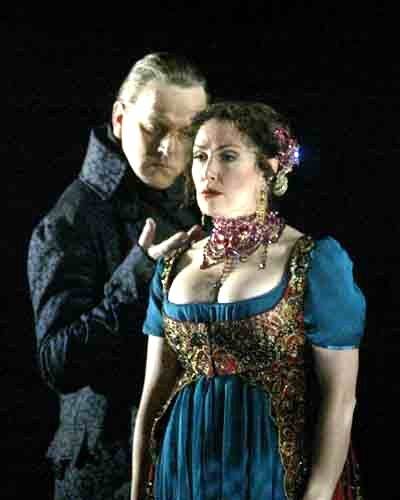S & H Opera Review
Puccini, ‘Tosca’, ENO, 21st November 2002 (MB)
ENO’s new production of Tosca is a beautifully sung affair, especially so given that this is an opera not noted for its lyrical expansiveness. But what surprises – particularly given recent new productions at this opera house – is the conservatism of the staging. There is no revisionism here, just a plain old Tosca as it might have been staged 80 years ago, a Tosca that is deserving of the label a ‘shabby little shocker’.
Black is clearly in vogue again. It dominates each act, internally and externally – from the interior of the church of Sant’ Andrea della Valle, with a crucifix suspended at an angle, to Scarpia’s apartment at the Palazzo Farnese, barely lit by candles, to the platform in the Castel Sant’ Angelo from which Tosca will eventually kill herself. It is atmospheric and gloomy in a dank sort of way – one might imagine water seaping through the walls of Scarpia’s apartment so inhospitable it appears. Think of Murnu or any other German expressionist director from the 1920s and this staging recalls films such as Nosferatu or M rather than more modern psycho-chillers. It is almost as if the set designer, Michael Vale, had never seen the recent film version of Tosca by Benoit Jacquot, so opulent in its colouring and staging.
Indeed, this may well be the only significant fault with this production since it focuses the attention so clearly on the stage action. And the acting in this production is neither incisive nor dramatic enough to compare with the best Toscas. A neat irony in both this production and in Jacquot’s film is that we have two husband-and-wife teams on stage together, the difference being that here it is the Tosca of Cheryl Barker and the Scarpia of Peter Coleman-Wright (in the film it is Gheorghiu’s Tosca and Alagna’s Cavaradossi). In part this is an advantage – rarely has a Tosca been so bitter towards her Scarpia as Barker is here, venomously spitting into his face like a snake one moment (audible gasps from the audience), then revelling in the almost necrophiliac seduction of his corpse the next. There is malevolence in their chemistry – a chemistry rather lacking in her love for Cavaradossi, sung heroically by John Hudson. The disadvantage is that this Tosca and this Scarpia do seem to know each other rather better than the plot suggests. It is credible, but only just.
Coleman-Wright is certainly no Raimondi, the leading Scarpia of the last 50 years, but he brings enormous vitality to the role. Especially memorable is his singing in his Act I aria where he describes his desire to possess Tosca but one misses the sheer malevolence which Raimondi brings to the role. Coleman-Wright is superlative in Act II – perhaps a little prop bound, as all the singers are given the minimalism of the set – but he is chilling in his reply to Tosca when she asks how much it would take to save Cavaradossi’s life. This is Scarpia as predator.
He has a deep-toned baritone voice capable of riding over the orchestra when required but is also able to distil that power into singing of swarthy hedonism; and of all the principals he is the one whose command of the English legato most persuades. Cheryl Barker’s Floria is notable for the beauty of her tone – this is a voice which is as mellifluous as one could wish for, seductive in its power and thrilling in its ability to throw out the most exultant top C with pin-point precision. Although both slightly older and physically smaller (not helped by the fact she wears no shoes) than an ideal Tosca she relies on her voice to give shape to her character in a way a better endowed actress might not have to but the result can be majestic: her singing of ‘Life has taught me singing and loving’ is beautifully phrased, even if her English is all but inaudible (a problem she shares with her Cavaradossi, John Hudson). Hudson himself is rather anodyne in Act I – hardly the ideal lover, almost the antithesis of it – but in Act II he is a powerful hero, his voice easily carrying from beneath the stage as he is tortured. He brings great beauty of tone to his Act III aria, ‘All the stars shone in heaven’ but to all intents and purposes his characterisation is wretchedly done; this is a Cavaradossi I would willingly sacrifice and certainly not go over the precipice for. That this Tosca does (and Cheryl Barker does one of the most convincing dives off the parapet I’ve ever seen in the opera house) is almost untenable.
Smaller roles are well sung from Nicholas Garrett’s Angelotti to Andrew Rees’ Spoletta, a characterisation made almost as odious as Scarpia’s. The ENO orchestra, sounding somewhat weighty under Mark Shanahan’s baton, provide excellent support, although some of the solo playing was shaky on press night, and ‘cellos were quite sour by Act III. If there is a criticism to be made of the singing it is that much of the English translation is inaudible. More problematical, from this reviewer’s point of view, is why anyone would wish to hear a production of this opera in English – Tosca’s withering cries of ‘Die! Die!’ simply lack the impact of the Italian ‘Morte! Morte!’ I doubt whether even Callas could make those monosyllabic words sound anything other than dull.
This is not a production which asks any profound questions about Tosca, on the contrary I rather think it is a production which attempts to strip the opera of its psychology. But it is well worth hearing, not least for the singing of its three principals.
Marc Bridle
Peter Coleman-Wright Scarpia & Cheryl Barker, Tosca
photographer: Alastair Muir

 Return to:
Return to: